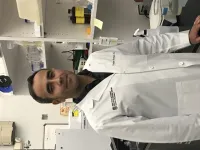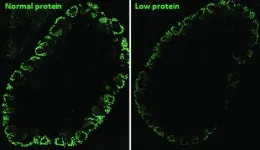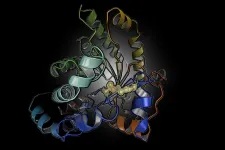(Press-News.org) A study published in July 2020 hypothesized a link between the presence of bradykinin, a well-known peptide, and severe cases of COVID-19. Vardan Karamyan, Ph.D., an associate professor and vice chair for the Texas Tech University Health Sciences Center (TTUHSC) Jerry H. Hodge School of Pharmacy Department of Pharmaceutical Sciences, had not previously conducted or evaluated any research related to COVID-19. However, he found the article intriguing because it discussed bradykinin, one of three specific peptides with which his lab has much well-published experience.
The paper received a lot of attention in both the media and scientific literature, but as Karamyan read through it, he felt it failed to address an equally important part of a bigger picture: the likely involvement of two other bioactive peptides, known as substance P and neurotensin, in the same processes and mechanisms proposed by the authors.
"I decided to write a focused review article on the topic and looked for journals which announced special issues devoted to COVID-19," Karamyan recalled.
Karamyan learned that the American Physiological Society (APS) had two journals with ongoing special issues focusing on COVID-19. Because APS has a membership base of highly accomplished scientists and a wide audience, Karamyan submitted the manuscript of his focused review to Physiological Reports, one of APS's peer-reviewed journals that published Karamyan's review in its March 2021 issue.
In the original article, which included the author's data and additional information from other research, Karamyan saw that the researchers had postulated that bradykinin was the peptide at the center of many of the complications experienced by patients with severe COVID-19 cases. Peptides are short chains composed of at least two and no more than 50 amino acids, which also are the building blocks of proteins.
"What they were saying makes sense, and it is really beautifully done; they branch out quite a bit and they put things together in a very systematic way," Karamyan explained. "But what was very surprising is that if their proposed mechanism was true, then two other peptides (substance P and neurotensin) should also be next to bradykinin; yet there was not even a single word about those two peptides."
Karamyan said it was obvious the original study arrived at some important findings, but he also knew that a basic tenant of science says the better any disease is understood, the better the chances of curing or managing it.
"That was their motivation too," Karamyan asserted. "Their study tells us, 'Look, maybe this is what is happening,' and that made me think that I really need to try to bring awareness that there are these two other peptides that could be equally important."
Almost since the pandemic began, research has shown that many of the worst cases of COVID-19 are related to cytokine storms, which is when the body overproduces cytokines in an effort to fight the virus. Cytokines are substances such as proteins, peptides or glycoproteins that are released by cells within the immune system to affect other cells. For instance, cytokines help the body manage conditions such as immunity, inflammation and hematopoiesis (the production of blood cells and platelets). When they are overproduced, however, the resulting cytokine storm can have deleterious effects.
"In the beginning, it's a compensatory reaction when the cytokines are produced, but when it is overdone, this makes things much worse," Karamyan added.
Using their own data and that put forward by previous investigators, the researchers who authored the original paper concluded it was the overexpression of bradykinin, or a bradykinin storm rather than a cytokine storm that was adversely affecting COVID-19 patients.
"As I noted, it makes sense," Karamyan said. "It's not that cytokines don't do anything, but I agree with them that bradykinin could make things worse."
To make their case, the authors of the original paper showed there were mechanisms that would make bradykinin appear to be upregulated, or increased within the body, while other mechanisms meant to degrade bradykinin are downregulated, or decreased. Karamyan said those same mechanisms also would affect substance P and neurotensin in the same manner at least 80% of the time.
"Those same mechanisms, or the majority of them, would lead to elevated levels of not just bradykinin, but also substance P and neurotensin," Karamyan said. "That's one fact; the second is that if this inflammation is going on, if things are deteriorating in a COVID-19 patient, in the same way that bradykinin is making things worse, these peptides are known to do the same thing, and the number one thing is where the vasculature becomes leaky and we have edema formation and so on."
Karamyan said the third fact he pointed out in his review is from his own collaborative and preliminary study with TTUHSC colleague Abraham Al-Ahmad, Ph.D., where they showed that these three peptides together -- bradykinin, substance P and neurotensin -- make more profound changes in vascular permeability than each of them produce alone. Vascular permeability refers to a blood vessel wall's capacity to allow other molecules and cells to pass through.
"When they're together, bradykinin, substance P and neurotensin kind of have this synergetic or combined effect," Karamyan said.
If those three peptides are concurrently available, Karamyan continued, they could adversely affect COVID-19 patients and lead to some of the conditions the authors mentioned such as vascular permeability, oxidative stress, inflammation, edema and others. He coined the term "vasoactive peptide storm" to describe the process.
"It's a made-up term, yes, but all three are vasoactive peptides that would do similar things," Karamyan said. "That's why I suggested a vasoactive peptide storm."
In the original paper, the authors proposed using drugs known as receptor blockers that can prevent or reduce the impact of bradykinin. Karamyan agreed, but suggested adding receptor blockers for substance P and neurotensin to yield better results. In fact, Karamyan's lab may already have an enzyme that can inactivate all three, though he said the approach is speculative at this point.
"An enzyme that we are working with called neurolysin actually degrades all three peptides," Karamyan said. "It inactivates bradykinin, neurotensin and substance P. An alternative approach -- again highly speculative -- could perhaps be instead of using three different drugs to block all three peptides, possibly using one enzyme to get rid of all three peptides."
Whether Karamyan decides to investigate the significance and impact of the so-called vasoactive peptide storm, or leave it for others more accustomed to working with COVID-19, Karamyan believes he may have found another piece to the pandemic puzzle. He and several colleagues have discussed testing the ability of neurolysin to deactivate all three peptides.
"These reviewers were telling me this is something that makes sense and is worthy of trying experimentally," Karamyan said. "Obviously, it was very pleasant to hear this and it gave me confidence. Since then, I'm kind of on the border. It would be some deviation from what I do in regards to the disease itself. In regards to the mechanisms, no, because this is my field: peptides and enzymes. As of now I don't have anything planned yet, but it is possible that I may, or we may collectively as a group look into it."
INFORMATION:
A new service piloted at Penn Medicine allowed a proportion of patients to avoid hospitalization by providing them with greater support after visiting the emergency department. The vast majority of the patients enrolled in the service - nearly 9 out of 10 - did not need to return to the hospital for care in the month that followed their initial visit. The study was published in Healthcare.
"The culture is shifting where we realize that hospitalization is not always the best option for patients - particularly patients with chronic illness," said one of the study's lead authors, Austin Kilaru, MD, an emergency physician at Penn Medicine. "We need to find better ways of helping patients not just get healthy in a hospital, but stay healthy at ...
Leather is an ever growing multi-billion dollar industry requiring more than 3.8 billion bovine animals - equal to one for every two people on earth - to sustain production each year. And while the products - clothing, shoes, furniture and more - can be quite elegant and durable, the environmental impact of leather production has been severe, leading to deforestation, water and land overuse, environmental pollution, and greenhouse gas emissions.
Researchers at Tufts University School of Engineering set out to find an alternative to leather, with similar texture, flexibility and stiffness, yet focused on materials that are sustainable, non-toxic, and friendly to the environment. It turns out, we have been wearing that material ...
PITTSBURGH, May 5, 2021 - Subtle differences in the shape of the brain that are present in adolescence are associated with the development of psychosis, according to an international team led by neuroscientists at the University of Pittsburgh School of Medicine and Maastricht University in the Netherlands.
In results published today in JAMA Psychiatry, the differences are too subtle to detect in an individual or use for diagnostic purposes. But the findings could contribute to ongoing efforts to develop a cumulative risk score for psychosis that would allow for earlier detection and treatment, as well as targeted therapies. The discovery was made with the largest-ever ...
Besides being underweight, babies born to women whose diet lacked sufficient protein during pregnancy tend to have kidney problems resulting from alterations that occurred while their organs were forming during the embryonic stage of their development.
In a study published in PLOS ONE, researchers affiliated with the University of Campinas (UNICAMP) in the state of São Paulo, Brazil, discovered the cause of the problem at the molecular level and its link to epigenetic phenomena (changes in gene expression due to environmental factors such as stress, exposure to toxins or malnutrition, among others).
According to the authors, between 10% and 13% of the world population ...
Researchers from the University of Liverpool have shown the potential of repurposing an existing and cheap drug into a long-acting injectable therapy that could be used to treat Covid-19.
In a paper published in the journal Nanoscale, researchers from the University's Centre of Excellence for Long-acting Therapeutics (CELT) demonstrate the nanoparticle formulation of niclosamide, a highly insoluble drug compound, as a scalable long-acting injectable antiviral candidate.
The team started repurposing and reformulating identified drug compounds with the potential for COVID-19 therapy candidates within weeks of the first lockdown. Niclosamide is just one of the drug compounds identified and has been shown to be highly effective against SARS-CoV-2 in a number of laboratory studies.
Using ...
New Johns Hopkins University simulations offer an intriguing look into Saturn's interior, suggesting that a thick layer of helium rain influences the planet's magnetic field.
The models, published this week in AGU Advances, also indicate that Saturn's interior may feature higher temperatures at the equatorial region, with lower temperatures at the high latitudes at the top of the helium rain layer.
It is notoriously difficult to study the interior structures of large gaseous planets, and the findings advance the effort to map Saturn's hidden regions.
"By ...
The incorporation of boron into polycyclic aromatic hydrocarbon systems leads to interesting chromophoric and fluorescing materials for optoelectronics, including organic light-emitting diodes (OLEDS) and field-effect transistors, as well as polymer-based sensors. In the journal Angewandte Chemie, a research team has now introduced a new anionic organoborane compound. Synthesis of the borafluorene succeeded through the use of carbenes.
Borafluorene is a particularly interesting boron-containing building block. It is a system of three carbon rings joined at the edges: two six-membered and one central five-membered ring, whose free tip is the boron atom. While neutral, radical, and cationic (positively ...
Proteins perform a vast array of functions in the cell of every living organism with critical roles in almost every biological process. Not only do they run our metabolism, manage cellular signaling and are in charge of energy production, as antibodies they are also the frontline workers of our immune system fighting human pathogens like the coronavirus. In view of these important duties, it is not surprising that the activity of proteins is tightly controlled. There are numerous chemical switches that control the structure and, therefore, the function of proteins in response to changing environmental conditions and stress. ...
Philadelphia, May 5, 2021--When Luke Terrio was about seven months old, his mother began to realize something was off. He had constant ear infections, developed red spots on his face, and was tired all the time. His development stagnated, and the antibiotics given to treat his frequent infections stopped working. His primary care doctor at Children's Hospital of Philadelphia (CHOP) ordered a series of blood tests and quickly realized something was wrong: Luke had no antibodies.
At first, the CHOP specialists treating Luke thought he might have X-linked agammaglobulinemia (XLA), a rare immunodeficiency syndrome seen in children. However, as the CHOP research team continued investigating Luke's case, they realized Luke's condition was unlike any disease described ...
Pesticides have been used in European agriculture for more than 70 years, so monitoring their presence, levels and their effects in European soils quality and services is needed to establish protocols for the use and the approval of new plant protection products.
In an attempt to deal with this issue, a team led by the prof. Dr. Violette Geissen from Wageningen University (Netherlands) have analysed 340 soil samples originating from three European countries to compare the contentdistribution of pesticide cocktails in soils under organic farming practices and soils under conventional practices. This study was a combined effort of 3 EC funded projects addressing soil
quality: RECARE (http://www.recare-project.eu/), iSQAPER (http://www.isqaper-project.eu) ...





